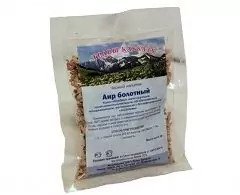Glycyram
Instructions for use:
- 1. Release form and composition
- 2. Indications for use
- 3. Contraindications
- 4. Method of application and dosage
- 5. Side effects
- 6. Special instructions
- 7. Drug interactions
- 8. Analogs
- 9. Terms and conditions of storage
- 10. Terms of dispensing from pharmacies

Glycyram is a drug that stimulates the function of the adrenal glands, which has an expectorant and anti-inflammatory effect.
Release form and composition
- Tablets: round, biconvex, white with a brownish or yellowish tinge, with splashes (10 pcs. In blisters, in a cardboard box 1, 2, 3 or 5 packages; 50 pcs. In dark glass jars, in a box cardboard 1 can);
- Dosed granules for the preparation of oral solution for children (1.3 g sachets, 30 sachets in a cardboard box).
The active ingredient is glycyram (monoammonium salt of glycyrrhizic acid obtained from a thick extract of the roots and rhizomes of licorice naked and licorice of the Ural or licorice root):
- 1 tablet - 50 mg;
- 1 dose of granules - 25 mg.
Excipients of tablets: colloidal silicon dioxide (Aerosil A380), sodium chloride, microcrystalline cellulose, calcium stearate.
Indications for use
- Complex therapy of diseases of the respiratory tract with difficult sputum, incl. mild forms of bronchial asthma;
- Hypofunction of the adrenal cortex due to prolonged therapy with glucocorticosteroids (GCS);
- Prevention of withdrawal syndrome during the period of cessation of GCS therapy or lowering the dosage of glucocorticosteroids (to reduce the dose of prednisolone in children with severe forms of bronchial asthma);
- Asthenic conditions and hypotonic syndrome;
- Diencephalic-pituitary forms of Addison's disease (including in combination with adrenocorticotropic hormone);
- Dermatoses, allergic dermatitis, eczema in children;
- Sheehan's syndrome.
Contraindications
- Hepatic and / or renal failure;
- Organic damage to the heart and parenchymal organs (kidney, liver);
- Children under 12 years of age (for tablets);
- Pregnancy and lactation;
- Individual hypersensitivity to components.
Method of administration and dosage
Pills
Glyceram tablets should be taken orally half an hour after a meal.
Adults and adolescents over 12 years old are prescribed 1-2 tablets 2-4 times a day. In severe cases, the dose is increased to 2 tablets 3-6 times a day.
Treatment can last from 2 weeks to 6 months.
Granules
In the form of granules, Glycyram is prescribed for children. The drug should be taken orally, half an hour after a meal, 1 dose (1 sachet), after dissolving it in 20 ml of warm boiled water.
The frequency of admission depending on the age of the child:
- 5-10 years old - 3-4 times a day;
- 3-5 years - 3 times a day;
- 5 months-3 years - 2 times a day.
Treatment can last from 3 to 30 days.
The doctor may increase the dose if necessary.
Side effects
Glycyram is generally well tolerated. In rare cases, allergic reactions are possible, with prolonged use - a delay in the removal of water from the body.
special instructions
In case of an overdose, there is a risk of developing hepatotoxic phenomena. Treatment is symptomatic.
Drug interactions
Glycyram can enhance the effect of drugs that stimulate the function of the adrenal cortex.
Analogs
Analogues of Glycyram are: Calceks, Lymphomyosot, Echinacea purpurea herb, Echinacea dry extract, Echinacea tincture.
Terms and conditions of storage
Store at temperatures up to 25 ºС in a place protected from light and moisture, out of reach of children.
Shelf life of granules - 2 years, tablets - 5 years.
Terms of dispensing from pharmacies
Available without a prescription.
Information about the drug is generalized, provided for informational purposes only and does not replace the official instructions. Self-medication is hazardous to health!







